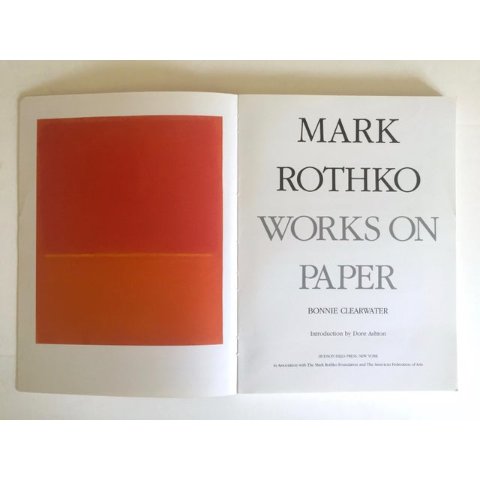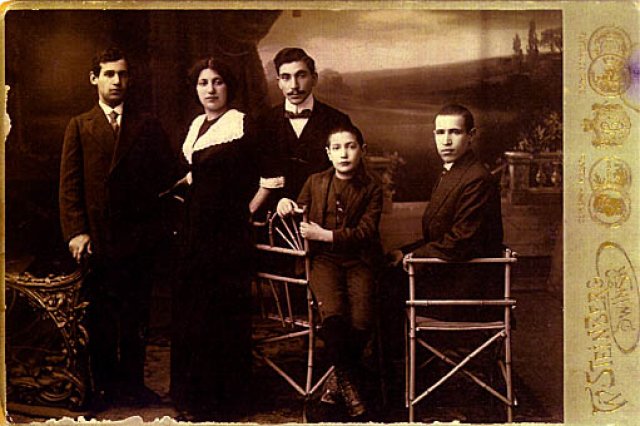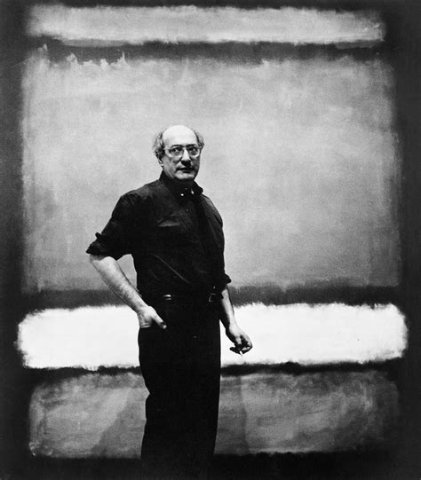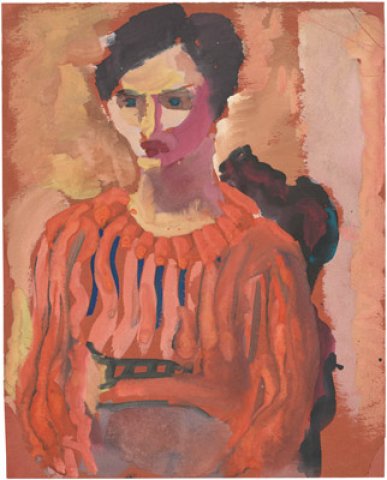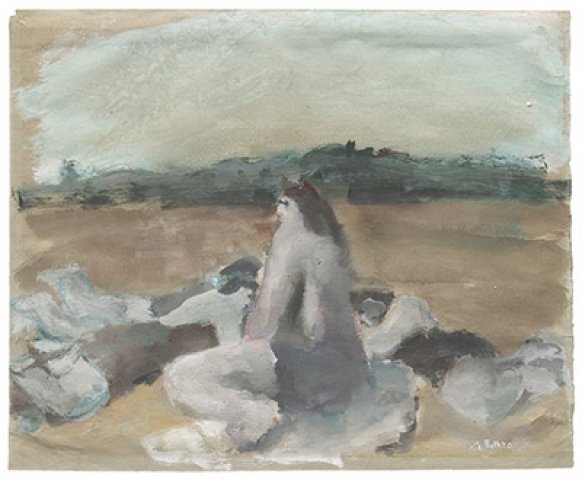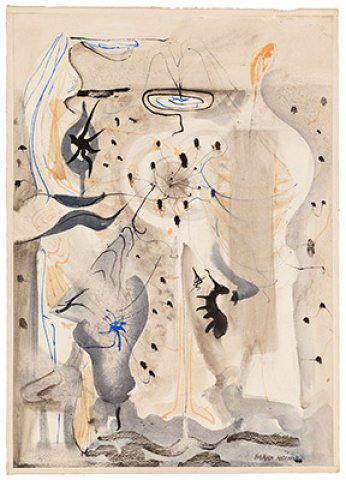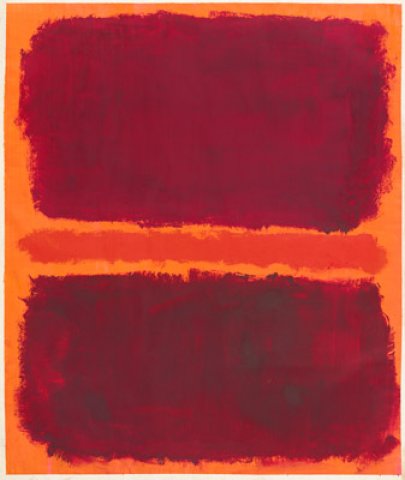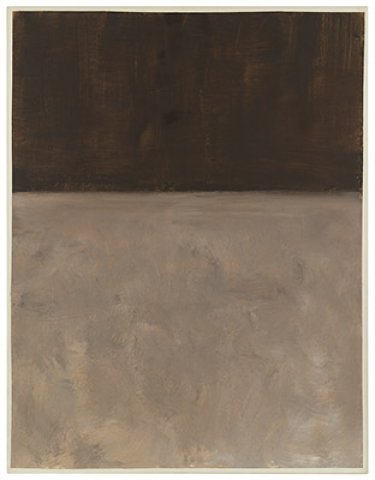Major Mark Rothko Exhibitions
Paris and Washington, D.C.
By: Charles Giuliano - Dec 27, 2023
Mark Rothko
Paintings on Paper
by Adam Greenhalgh
200 Pages, 8.75 x 11.00 in, 124 color illus.
ISBN 9780300266474
Yale Press, 2023
$45.
Mark Rothko, born Markus Yakovlevich Rothkowitz in Latvia, (1903-1970 by suicide) is one of the most revered but disrespected and misunderstood artists of his generation. He went through several phases from landscape and figure painting, to cityscapes and subways, then automatic surrealism, until multiforms then the mesmeric color abstractions of suspended, feather edged, clouds of color that became his signature and most coveted style.
When he died works disappeared from the studio. Christopher Rothko and his older sister, Kate Rothko Prizel, who was 19 when her father died, prevailed in a ten year suit in the 1970s against Rothko’s executors and the Marlborough Gallery, which they accused of defrauding the estate. Their mother died six months after her husband’s suicide. Eventually, hundreds of paintings were returned to the estate, with $9 million in fines, and damages levied against the executors and the gallery. The Rothko Foundation has distributed more than 1,000 Rothko works to museums in the United States and abroad.
The largest holding of Rothko’s work is the National Gallery in Washington, D.C. There is the beloved Rothko Chapel in Houston commissioned by John and Dominique de Menil. Harvard University has the scorched remnants of its light damaged Holyoke Center murals. Rothko withdrew, as a matter of conscience, from a commission for the upscale Four Seasons Restaurant in New York’s Seagram building. He stated that he did not want his paintings contemplated by “bastards.” They went to Tate Modern.
Currently, there are two, once-in-a lifetime exhibitions of his work. Through April 2, 2024, more than a hundred paintings are on display at the Fondation Louis Vuitton, Paris. Through March the National Galley has Mark Rothko: Paintings on Paper with a hundred works drawn from all phases of his career.
The artist created a thousand drawings with finished pieces as well as sketches and studies. In mature work he regarded drawings as equal to his paintings, Cut from large rolls the works on paper were at times on the same scale as large abstractions. Particularly in the late period he made more work on paper than canvas.
Both exhibitions have overcome daunting conservation and funding challenges. In 2021, one of his paintings sold at auction for $82.5 million. That spiked the value of the work to a level that museums cannot afford to ship and insure. The Harvard paintings document that they are fragile particularly when, as with the Holyoke series, he experimented with fugitive materials, in particular, lithol red. I covered a rare Harvard Rothko exhibition and conservation study for Art News.
The Paris exhibition is underwritten by Vuitton’s founder, the world’s second-richest man; Bernard Arnault. Drawing from its own holdings the NG project is an in-house affair. But work on paper entailing color may only safely be shown once every decade. In a few months the museum will again display its depth in paintings by Rothko. We will be on the road and plan to see the memorable D.C. exhibition.
Until then, we have the superb catalogue with state of the art reproductions. The essay by curator Adam Greenhalgh is pithy and provocative. It provides a chronological overview of the artist’s development. He breaks it down into several sections and periods. The least familiar were the early ones as the artist struggled to find an identity and support his family. There was a turning point with the surrealist works of the 1940s, the transitional “multi form” paintings then a breakthrough resulting in fame and fortune.
Like many peers of the abstract expressionist generation, eventual success failed to balance the decades of self-abuse and privation. Jackson Pollock, an alcoholic, slammed a car into a tree. Willem de Kooning suffered alcoholism and dementia. After an aneurism and severe depression, against advice, Rothko continued to drink and chain smoke. Recently separated from his wife he lived in the studio.
Compared to his peers, the Action Painters- Pollock, de Kooning, Robert Motherwell and Franz Kline- the works of Rothko appear to be serene and sublime, meditation-inducing excursions of color. Surprisingly, he described himself as the most “violent” of the group. If all one sees is the seductive color then, he said, you have missed the point.
“Behind the color lies the cataclysm,” he said in 1959, “I’m only interested in expressing basic human emotions — tragedy, ecstasy, doom, and so on,” he commented in 1957, denying any interest in the mechanics of abstraction or color. There is the complex matter of correctly naming or categorizing his work. The work is abstract but not expressionist. Because of floating tinted lozenges he has erroneously been linked to color field painting. That was a term applied by Clement Greenberg after Helen Frankenthakler’s breakthrough 1952 stain painting “Mountains and Sea.” Rothko overlapped but was not connected to the Washington, D. C. color field painters Morris Louis and Kenneth Noland or Jules Olitski.
Rothko is better linked to New York School peers Ad Reinhardt, Barnett Newman tailing off to Philip Guston, Leon Polk Smith, Jack Tworkov, Esteban Vicente and Peter Busa. This is the more still and serene end of the pool.
The young Rothko had many peers and influences. He attended Yale in 1922 but quit at the end of his sophomore year. He ended up at the Art Student’s League with Arshile Gorky as an instructor.
In the early 1930s, Rothko met Adolph Gottlieb, who, along with Barnett Newman, Joseph Solman, Louis Schanker, and John Graham, was part of a group of young artists surrounding the painter Milton Avery.
During the summers of 1933-34 Rothko was in Gloucester with Avery and Gottlieb. Works in the NG catalogue from that time show Rothko painting blobby bathers in the manner of Avery. This group is the focus of an upcoming exhibition for the Cape Ann Museum that is being guest curated by Eliza Rathbone.
A mature style began to emerge in the 1940s. Peggy Guggenheim, with her husband, Max Ernst, had rescued leading surrealists from Nazi occupied Paris. Under its leader, Andre Breton, they remained tight and insular. Gorky joined the group but was not embraced. Automatic surrealism and Jungianism leeched into the emerging New York artists. Rothko’s work in this manner fascinates but is little known and appreciated. One of the major works from this period is “Slow Swirl at the Edge of the Sea” (1941, collection MoMA).
Rothko had fixed idea as to how his work should be seen and appreciated. For the mature abstract works he insisted on dim, reflected natural lighting. He wanted viewers to be immersed into life sized and larger paintings. When possible they were to be viewed with separation from works by other artists.
In 1964 he was given full artistic control to create work for what is known as The Rothko Chapel. He clashed with the project's original architect, Philip Johnson. The plans went through several revisions and architects. Rothko continued to work first with Howard Barnstone and then with Eugene Aubry. He did not live to see the chapel's completion in 1971.
It was deeply moving to spend time in the chapel some years ago. One adjusted to the low level of natural light focusing, or meditating, on each work in the octagon-shaped room with domed ceiling. There were places to sit and read from a selection of religious books. My younger mind was too agitated for the stillness experience that the artist intended. No doubt it would be more meaningful today given another opportunity.
In November 1958, Rothko gave an address to the Pratt Institute. He discussed art as a trade and offered the
"recipe of a work of art—its ingredients—how to make it—the formula
- There must be a clear preoccupation with death—intimations of mortality ... Tragic art, romantic art, etc., deals with the knowledge of death.
- Sensuality. Our basis of being concrete about the world. It is a lustful relationship with things that exist.
- Tension. Either conflict or curbed desire.
- Irony, This is a modern ingredient—the self-effacement and examination by which a man for an instant can go on to something else.
- Wit and play ... for the human element.
- The ephemeral and chance ... for the human element.
- Hope. 10% to make the tragic concept more endurable.
I measure these ingredients very carefully when I paint a picture. It is always the form that follows these elements and the picture results from the proportions of these elements."
In his final years he had all the work removed from storage and taken to the studio. His assistant logged a vast inventory including paintings and works on paper. Scholars speculate that, as a result of the experience, he drew from the early works, particularly in matters of color. The Avery influenced beach and flesh tones were reintroduced. No doubt this is a theme that Rathbone will explore for the Gloucester exhibition.
In the three mural cycles- Harvard, Menil, Seagram- the artist created closely related serial works. As critics and visitors comment there can be a deadening sameness when viewing numerous closely related works. Comments on the Washington Post review include dismissing the work as merely decorative. Such remarks are familiar but ignorant. It is challenging to experience the nuances intended by the artist. The viewer may be lulled into feelings of monotony. The aha moment comes when one succumbs to the experience. That can be difficult at a crowded exhibition. A hit of sunshine helps on such occasions.
This is particularly true for the group of final works. They are bifurcated canvases and numerous works on paper. A notable characteristic is absence of chroma. There is a washy black above and variations of gray and beige below. A norm has been to view them as exsanguinated from the artist’s familiar shimmering color, particularly red, yellow and what lies between.
The artist staged a studio viewing for friends and associates. There were mixed and negative responses. Given the suicide that followed soon after they were dismissed as premonitions of doom. Scholars now reason that they coincide with our first moon landing and widely photographed images. It was his intent to show them with sculpture by Giacometti. That has now occurred, reportedly with stunning results, in Paris.
Addressing an audience at the National Gallery, curator Adam Greenhalgh made a compelling argument for their reevaluation. Dismissing the iconography of demise he revealed that simultaneously he created several large, life affirming, joyous canvases with soft color including muted lavender. His argument is difficult to dismiss.
Surprisingly, he inserted a self-effacing remark. With a “me too” grimace he revealed that Rothko had nothing but contempt for curators and critics. It’s not the first time an artist has told me that to my face. But I rather enjoy my role as a pilot fish swimming with the sharks. One can have a life and career feeding on the detritus of genius.

